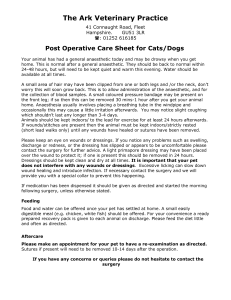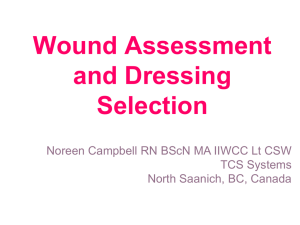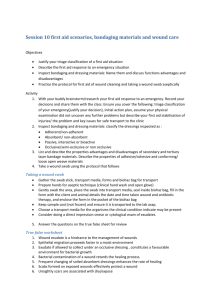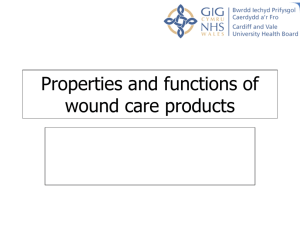Dressings
advertisement
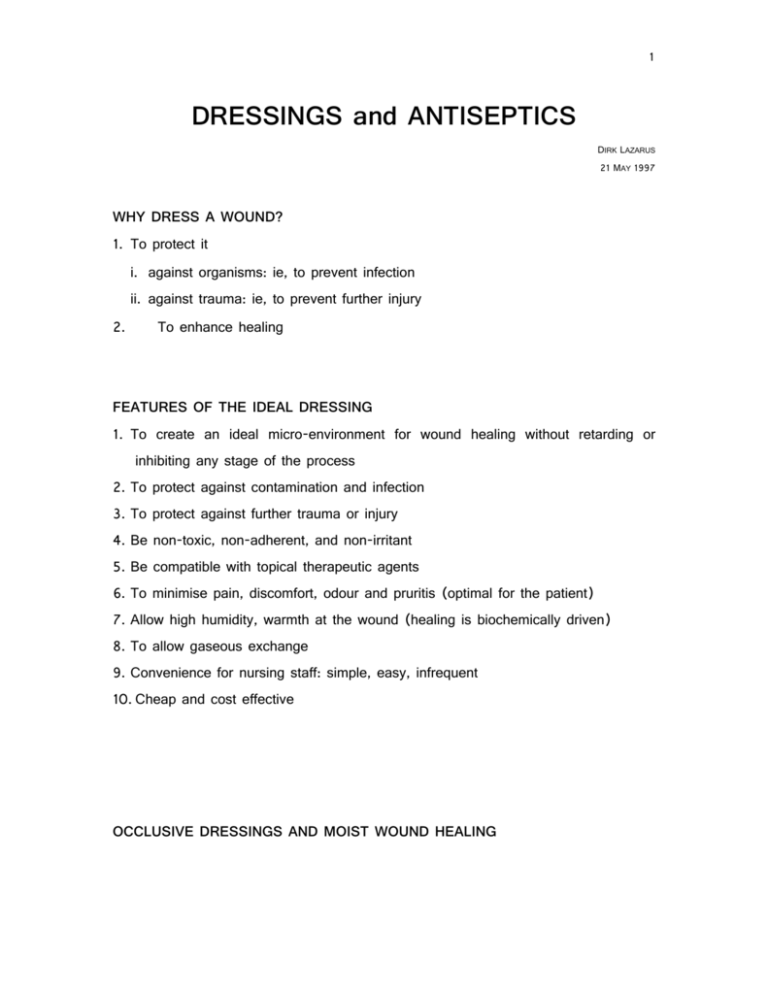
1 DRESSINGS and ANTISEPTICS DIRK LAZARUS 21 MAY 1997 WHY DRESS A WOUND? 1. To protect it i. against organisms: ie, to prevent infection ii. against trauma: ie, to prevent further injury 2. To enhance healing FEATURES OF THE IDEAL DRESSING 1. To create an ideal micro-environment for wound healing without retarding or inhibiting any stage of the process 2. To protect against contamination and infection 3. To protect against further trauma or injury 4. Be non-toxic, non-adherent, and non-irritant 5. Be compatible with topical therapeutic agents 6. To minimise pain, discomfort, odour and pruritis (optimal for the patient) 7. Allow high humidity, warmth at the wound (healing is biochemically driven) 8. To allow gaseous exchange 9. Convenience for nursing staff: simple, easy, infrequent 10. Cheap and cost effective OCCLUSIVE DRESSINGS AND MOIST WOUND HEALING 2 Occlusive dressings keep the wound moist. These dressings have revolutionised wound care and there is increasing body of evidence confirming their superiority over old fashioned gauze and other non-occlusive dressings. The advantages of occlusive dressings and a moist wound healing environment were first shown in a landmark study by Winter (Nature, 1962) who showed that in the porcine burn model, wounds covered with an occlusive dressing (polyethylene film) healed 40% faster than those exposed to air. These dressings have been slow to catch on for 2 main reasons: the fear that moisture promotes infection and the expense of the individual dressings. Both these reasons have been shown to be fallacious and occlusive dressings have been shown to have a number of other advantages over previously more conventional dressings. A number of studies have shown lower infection rates beneath occlusive dressings than beneath non-occlusive dressings (2.6% for occlusive vs 7.6% for non occlusive, Hutchinson, Mertz). Both contamination and infection (105 offending orgs per gram of tissue plus histological invasion, Robson) rates are for a number of reasons: 1. Mechanical barrier to microbial penetration, therefore contamination from staff to patient and from patient to patient. airborne dispersal of microbes with each dressing change. 3. Fewer dressing changes required. 4. Lower pH maintained beneath an occlusive dressing which inhibits microbial proliferation and promotes angiogenesis. 5. Viable host defences are maintained: WBC phagocytic and lysozomal functions and neutrophil inflammatory responses are less impaired. Fewer dressing changes results not only in less pain for the patient, but also less cost (labour and materials). The removal of a dry dressing often causes re-injury to the wound which is avoided with occlusive dressings. 3 The moist environment is beneficial for a number of other reasons: 1. Enhances keratinocyte migration: The re-epithelialisation rate is faster (Bolton et al) in part due to prevention of eschar 2. Allows GF’s to be maintained where they are needed. 3. Establishes a beneficial electric current across the wound. 4. Thermal insulation 5. Increased partial pressure of O2 with semipermeables 6. The patient experiences less pain and can bathe and continue the activities of daily living. 7. Reduced nursing requirements. 8. The bacterial flora change from G+ve to G-ve. With partial thickness wounds, dry dressings is acceptable as there is little evaporative loss. With full thickness loss, allowing wound to dry can be detrimental 1. evaporative loss – loss of cellular signals as this depends of diffusion of soluble factors 2. changing zone of stasis into zone of necrosis There is an enhanced milieu in which the cells can function. According to Colin Song, although there is a moist environment beneath an occlusive dressing, there are fewer bacteria d/t the presence of bacterostatic substances in the wound fluid. In dry wounds the bacteria go deeper to seek moisture and infection is more deep seated. Note that all these advantages are applicable to acute wounds and have not been experimentally proven in chronic wounds d/t the lack of an experimental model. Disadvantages 1. Maceration (hence the use of semi-permeable dressings) 4 2. Although these dressings provide a physical barrier to exogenous organisms, they are unable to prevent infection once pathogens are introduced and may actually promote infection by encouraging bacterial proliferation, particularly with prolonged occlusion. CLASSIFICATION OF DRESSINGS I. Biological II. Nonbiological – occlusive, semi permeable, permeable Adherents Semi-permeable polyurethane (Tegaderm, opsite) Hydrocolloids (Granuflex) Alginates (Kaltostat) Non adherents Hydrogels (for heavily exudative wounds) (Intrasite gel, Nu-gel) Hydrofoams (for heavily exudative wounds) (Allevyn, Lyofoam) Semi-permeable polyurethane (Omniderm) Polyethylene net Laminates Semi-permeable dressings allow the escape of moisture vapour and gasses, but prevent the passage of bacteria and liquids. This is advantageous in preventing maceration. 1. Polymer Films eg, Tegaderm, Opsite. Transparent, adhesive, polyurethane films. Semi-permeable. 5 Use: Superficial wounds such as donor sites, abrasions and superficial decubitus ulcers. 2. Serous fluid can accumulate—not good for highly exudative wounds Polymer Foams eg, Allervyn (polyurethane absorbent foam dressing), Lyofoam. Foams that usually require a secondary dressing (such as polymer films) to hold it to the wound. They represent an attempt to deal with the lack of absorbency of polymer films without sacrificing the moist healing environment. Use: Deep, heavily exudative wound or chronic wound such as venous ulcers. Cavities. 3. Hydrogel Dressings eg, Intrasite gel, Debrisan beadlets Cross linked hydrophilic polymers, 96% water. Despite their high water content, have a high capacity for absorption. Non adherent and require a secondary dressing to keep them in position. Should not be left longer than 3 days without changing. Gel contains enzymes for auto debridement Not a good barrier against bacteria, allow overgrowth of G(-)s Have a cooling effect which contributes to analgesia and may limit the inflammatory response. Use: Partial thickness burns, donor sites and chronic wounds. 4. Hydrocolloid Dressings eg, Granuflex (gelatin, pectin, Na-carboxymethylcellulose) Outer polyurethane foam / middle hydrocolloid gelling agent (cellulose) / inner adhesive layer 6 Initially used as stoma barrier dressings. Inherently adhesive. Non permeable to water vapour and gases. Can be left in place for up to 7 days, but should be changed when it starts to leak. Uses: Chronic wounds, burns. 5. Alginates eg, Kaltostat Polysaccharide derived from kelp—Calcium alginate salts Ca from alginate undergoes ion exchange with Na from wound forming soluble Naalginate gel—moist wound environment and non-adherent Free Ca amplifies clotting cascade Exudate is needed for production of gel Don’t allow drying Use: Exudative wounds. 6. Non adherent dressings (tulle) eg, Jelonet, Bactigras, Sofra-tulle 7. Dry dressings eg, Primapore, Telflo 8. Medicated dressings eg, Zinc oxide tape, Viscopaste 9. Biobrane nylon mesh bonded to silicone and coated with porcine-like peptides Leave for 10/7, can granulate through holes, shiny side up Fix with glue or staples Melonin outer dressing 7 10. Xeroform Gauze impregnated with Xeroform (Bismuth Tribromophenate) + petroleum blend Biological Transcyte Alloderm Cadaveric Skin Porcine Xenograft Amnion CHOOSING A DRESSING Remember, 1. The wound is attached to a patient. 2. No single dressing is a panacea for all wounds. Consider, 1. Infection: Collin Song advocates “tincture of cold steel”. Others suggest appropriate antibiotics for adjacent or surrounding cellulitis or lymphangitis and bland antiseptics for contaminated or colonised wounds. 2. Aetiology of the wound and whether acute or chronic 3. Location of the wound 4. Granulation tissue: Inhibitors of granulation tissue: silver nitrate, acetic acid, hypochlorite (eusol), chlorhexidine dressings and topical steroids. Granulation tissue stimulants include hydrogel and hydrocolloid dressings. 8 5. Exudate - can be absorbed with old fashioned gauze or muslin or with more modern preparations such as hydrogels, hydrocolloids, etc. Mild exudate: hydrocolloid, hydrogel Moderate exudate: hydrocolloid, hydrofoam or PU Heavy exudate: hydrofoam, alginate 6. Cavitation, undermining 7. Maceration SLOUGH Slough should probably be removed surgically. Desloughing agents include: 1. Aserbine: Available as a cream or a solution and contains malic acid, benzoic acid, salicylic acid and propylene glycol. 2. Iruxol: An ointment containing collagenase clostridopeptidase A and proteases. 3. Varidase powder which contains streptokinase (100 000 u) and streptodornase. LOCAL ANTISEPTICS Povidone Iodine (Betadine) Broad spectrum local antiseptic with bactericidal and fungicidal properties. Many viruses, protozoa, yeasts, cysts and spores are susceptible. The effect is d/t the liberation of free iodine. Resistance does not occur. Iodine is complexed to povidone (PVP-I2) to facilitate the slow release of iodine. Tincture of Iodine (free iodine) posses a very broad antimicrobial spectrum, a very short kill time in very low concentrations (0.5 to 2 parts per million). Especially useful against the G+ves: staphs and streps. LeVeen states that elemental iodine is potent (as above), but that when combined with povidone, insufficient free iodine is released to be effective for treating or 9 preventing infection. “It is a weak antiseptic that is marginally acceptable as a disinfectant for intact adult skin”. He proposes an Iodine-PU complex (Iothane®) Causes less tissue destruction than its closest competitor: chlorine. Contraindicated in patients with non-toxic nodular colloid goitre. Application to large areas of broken skin should be avoided as excess absorption of iodine may occur. Not to be used in pregnancy or lactating women. Not to be used in patients allergic to iodine. Hypersensitivity and local irritation may occur. Hypothyroidism can occur in neonates. Absorption of iodine may interfere with thyroid function tests. Systemic effects of OD include metabolic acidosis, hypernatraemia and renal impairment and may occur if applied to large denuded areas. Treatment is symptomatic and supportive. Silver Sulphadiazine (Flamazine, Bactrazine) Acts by the slow release of silver which is bacterocidal. Indicated particularly for G-ve orgs (Pseudomonas aeruginosa, etc) and Candida albicans. Exerts a therapeutic effect in burns that are already colonised (package insert states “infected”). Contraindicated in patients with hypersensitivity to sulphonamides. Can the possibility of kernicterus therefore C/I in pregnant women at term, in premature infants or in infants during the first months of life. Should not be used if hepatic or renal function become impaired. C/I in porphyrics. Safety not established in pregnancy and lactation. Can cause WBC count when used for burn dressings. Should be applied in a layer 3-5 mm thick which can be dressed or left open. 1 0 Beware of sensitivity reactions and acid base disturbances. Sensitivity is ed by exposure to sunlight. REFERENCES Clinics in Dermatology 12, 121, 1994. SRPS 8(1), 1995. SAMF Various package inserts Martindale
